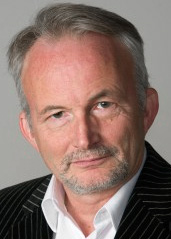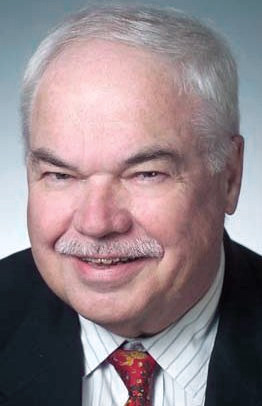/ Recently Commented
Ossification and the Internet
 Networks are typically built to provide certain services at an expected scale. The rationale for this focused objective is entirely reasonable: to overachieve would be inefficient and costly. So, we build service infrastructure to a level of sufficient capability to meet expectations and no more. In ideal conditions, this leads to a widely deployed and highly efficient infrastructure that is capable of supporting a single service profile. more
Networks are typically built to provide certain services at an expected scale. The rationale for this focused objective is entirely reasonable: to overachieve would be inefficient and costly. So, we build service infrastructure to a level of sufficient capability to meet expectations and no more. In ideal conditions, this leads to a widely deployed and highly efficient infrastructure that is capable of supporting a single service profile. more
- Geoff Huston
- Comments: 1
- Views: 25,622
Should WSIS End? A Call for Discussion
 The future of the World Summit on the Information Society (WSIS) process will be one of the main topics of the 2025 Internet Governance Forum. Many in the IG community are heavily invested in the renewal of WSIS. They imply that if it is not renewed, there will be major, negative effects on the way we govern the Internet. IGP believes that it is healthy and productive for the community to consider the possibility of ending WSIS. more
The future of the World Summit on the Information Society (WSIS) process will be one of the main topics of the 2025 Internet Governance Forum. Many in the IG community are heavily invested in the renewal of WSIS. They imply that if it is not renewed, there will be major, negative effects on the way we govern the Internet. IGP believes that it is healthy and productive for the community to consider the possibility of ending WSIS. more
- Milton Mueller
- Comments: 1
- Views: 28,824
Censorship-by-Infrastructure: How DNS Blocking Threatens the Open Internet—and How You Can Help Document It
 What happens when governments don't just regulate content, but forcibly repurpose the very guts of the Internet's infrastructure to enforce their policies? The chilling answer, increasingly evident worldwide, is widespread, devastating collateral damage. Around the world, neutral systems like Domain Name System (DNS) resolvers and IP routing, the bedrock of our digital lives, are being weaponized as enforcement tools. more
What happens when governments don't just regulate content, but forcibly repurpose the very guts of the Internet's infrastructure to enforce their policies? The chilling answer, increasingly evident worldwide, is widespread, devastating collateral damage. Around the world, neutral systems like Domain Name System (DNS) resolvers and IP routing, the bedrock of our digital lives, are being weaponized as enforcement tools. more
- Christian Dawson
- Comments: 1
- Views: 26,545
Beyond WHOIS: Rethinking Domain Verification in a Post-GDPR World
 The introduction of GDPR in 2018, and the subsequent tightening of privacy regulations around the world, was a necessary step toward protecting user data. Consumers gained critical rights over their personal information, and companies were forced to adopt stronger standards for how they collect, store, and use that data. However, one unintended consequence has been the erosion of access to domain registration information once easily available through WHOIS databases. more
The introduction of GDPR in 2018, and the subsequent tightening of privacy regulations around the world, was a necessary step toward protecting user data. Consumers gained critical rights over their personal information, and companies were forced to adopt stronger standards for how they collect, store, and use that data. However, one unintended consequence has been the erosion of access to domain registration information once easily available through WHOIS databases. more
- Rick Crandon
- Comments: 1
- Views: 38,821
Reporting To God
 "GOD, at least in the West, is often represented as a man with a flowing beard and sandals. Users of the Internet might be forgiven for feeling that nature is imitating art — for if the Net does have a god he is probably Jon Postel" (The Economist, Feb. 1997) David W. Maher, Senior Vice President, Law and Policy of Public Interest Registry (PIR) offers his reminiscence of the early days of the Internet and attempts made to restructure the Domain Name System — an article he has entitled 'Reporting to God'. more
"GOD, at least in the West, is often represented as a man with a flowing beard and sandals. Users of the Internet might be forgiven for feeling that nature is imitating art — for if the Net does have a god he is probably Jon Postel" (The Economist, Feb. 1997) David W. Maher, Senior Vice President, Law and Policy of Public Interest Registry (PIR) offers his reminiscence of the early days of the Internet and attempts made to restructure the Domain Name System — an article he has entitled 'Reporting to God'. more
- David Maher
- Comments: 3
- Views: 41,489
Why Digital Sovereignty Cannot Escape Its Own Contradictions? Reflections for Moving Forward
 The debate surrounding digital sovereignty has gained momentum in recent years, particularly within BRICS nations, where governments seek to assert greater control over their digital ecosystems. Proponents of digital sovereignty often frame it as a necessary countermeasure against foreign technological dominance, positioning it as either a "positive" force- fostering local innovation and self-reliance- or a "negative" one- fueling authoritarian control and economic isolation. more
The debate surrounding digital sovereignty has gained momentum in recent years, particularly within BRICS nations, where governments seek to assert greater control over their digital ecosystems. Proponents of digital sovereignty often frame it as a necessary countermeasure against foreign technological dominance, positioning it as either a "positive" force- fostering local innovation and self-reliance- or a "negative" one- fueling authoritarian control and economic isolation. more
- Imad Payande
- Comments: 2
- Views: 24,029
UN’s Global Digital Compact: A Fork in the Road for Internet Governance?
 As the United Nations' Global Digital Compact (GDC) approaches its expected adoption, a growing chorus of critics warns that it threatens the very foundations of multistakeholderism in Internet governance. While the GDC aims to foster global cooperation and advance shared objectives for digital transformation, it not only centralizes power within the UN but also sidelines the Internet Governance Forum (IGF) - a platform that has, for years, been instrumental in amplifying diverse voices, especially from marginalized communities and the private sector. more
As the United Nations' Global Digital Compact (GDC) approaches its expected adoption, a growing chorus of critics warns that it threatens the very foundations of multistakeholderism in Internet governance. While the GDC aims to foster global cooperation and advance shared objectives for digital transformation, it not only centralizes power within the UN but also sidelines the Internet Governance Forum (IGF) - a platform that has, for years, been instrumental in amplifying diverse voices, especially from marginalized communities and the private sector. more
- Imad Payande
- Comments: 1
- Views: 17,871
Internet Governance - the End of Multi-Stakeholderism?
 When the Internet outgrew its academic and research roots and gained some prominence and momentum in the broader telecommunications environment, its proponents found themselves in opposition to many of the established practices of international telecommunications arrangements and even in opposition to the principles that lie behind these arrangements. more
When the Internet outgrew its academic and research roots and gained some prominence and momentum in the broader telecommunications environment, its proponents found themselves in opposition to many of the established practices of international telecommunications arrangements and even in opposition to the principles that lie behind these arrangements. more
- Geoff Huston
- Comments: 4
- Views: 15,581
Remembering Dave Taht
 Dave Taht died on April 1st. I met him only recently, and never in person, but his passing saddens me. His technical work and evangelism have improved the Internet, and I will give some examples of his contributions to the Internet community and users, but I am sad because he was a good person -- idealistic, unselfish, open, and funny. I'll miss him. First, his contributions, then his values. more
Dave Taht died on April 1st. I met him only recently, and never in person, but his passing saddens me. His technical work and evangelism have improved the Internet, and I will give some examples of his contributions to the Internet community and users, but I am sad because he was a good person -- idealistic, unselfish, open, and funny. I'll miss him. First, his contributions, then his values. more
- Larry Press
- Comments: 1
- Views: 16,632
Time to Act as Apple Sets Wheels in Motion for Shorter Certificate Life Cycles
 You may have read our previous blog about the pending reduction of digital certificate life cycles to just 90 days. This past weekend, the issue gained momentum at the Certification Authority Browser Forum when more detail was discussed following the proposed ballot to set a timeline for shorter lifetime certificates by Apple. This creates real urgency for organizations of all sizes to seriously consider and implement automation into their certificate life cycle management. more
You may have read our previous blog about the pending reduction of digital certificate life cycles to just 90 days. This past weekend, the issue gained momentum at the Certification Authority Browser Forum when more detail was discussed following the proposed ballot to set a timeline for shorter lifetime certificates by Apple. This creates real urgency for organizations of all sizes to seriously consider and implement automation into their certificate life cycle management. more
- Mark Flegg
- Comments: 1
- Views: 10,625
Defending the Core: Why Internet Values Matter More Than Ever
 In today's rapidly shifting digital landscape, the question of whether the Internet can retain its foundational values has never been more urgent. As it increasingly permeates every aspect of human activity - from communication and commerce to governance and geopolitics - the Internet has evolved into both a shared global commons and a contested arena of power. At stake are its core values: global connectivity, openness, interoperability, decentralization, the end-to-end principle, robustness and reliability, and freedom from harm. more
In today's rapidly shifting digital landscape, the question of whether the Internet can retain its foundational values has never been more urgent. As it increasingly permeates every aspect of human activity - from communication and commerce to governance and geopolitics - the Internet has evolved into both a shared global commons and a contested arena of power. At stake are its core values: global connectivity, openness, interoperability, decentralization, the end-to-end principle, robustness and reliability, and freedom from harm. more
- Pari Esfandiari
- Comments: 1
- Views: 13,436
Cyber Resilience Resources Restructuring
 Information and Communications (ICT) infrastructures rely on many globally shared critical resilience information resources for diverse essential functions such as identifiers, routing, and cyber security. However, this ICT ecosystem has rapidly become significantly less stable and collaborative with dramatically diminished respect for legal norms and values because of the new USA national Administration. The instability includes the vicarious, wholesale removal of essential public safety and scientific databases, as well as global collaboration with multiple global UN public safety bodies. One result is the scaling of Digital Sovereignty initiatives. more
Information and Communications (ICT) infrastructures rely on many globally shared critical resilience information resources for diverse essential functions such as identifiers, routing, and cyber security. However, this ICT ecosystem has rapidly become significantly less stable and collaborative with dramatically diminished respect for legal norms and values because of the new USA national Administration. The instability includes the vicarious, wholesale removal of essential public safety and scientific databases, as well as global collaboration with multiple global UN public safety bodies. One result is the scaling of Digital Sovereignty initiatives. more
- Anthony Rutkowski
- Comments: 2
- Views: 14,797
The End of the Road: ICANN, Whois, and Regulation
 There's a well-documented crisis facing the domain name system: very few who rely on domain name registration data from the Whois database to perform vital functions can do so any longer, which is escalating consumer harm and abuse on the internet worldwide. And the problems, thanks to ICANN's overly restrictive policy post-GDPR and a failing policy process, are piling up. more
There's a well-documented crisis facing the domain name system: very few who rely on domain name registration data from the Whois database to perform vital functions can do so any longer, which is escalating consumer harm and abuse on the internet worldwide. And the problems, thanks to ICANN's overly restrictive policy post-GDPR and a failing policy process, are piling up. more
- Fabricio Vayra
- Comments: 9
- Views: 32,420
A Threat to Europe’s Digital Human Rights Stewardship
 In a contemporary era when the human rights, democracy, and the rule of law are under attack, Europe has asserted itself as the leading global digital steward for maintaining those values. However, doing so through its Digital Sovereignty initiatives is significantly dependent on the ability to produce timely technical standards that underpin the implementing legislation. more
In a contemporary era when the human rights, democracy, and the rule of law are under attack, Europe has asserted itself as the leading global digital steward for maintaining those values. However, doing so through its Digital Sovereignty initiatives is significantly dependent on the ability to produce timely technical standards that underpin the implementing legislation. more
- Anthony Rutkowski
- Comments: 3
- Views: 17,416
The Digital Sovereignty Ecosystem
 The terms Digital Sovereignty or Souveraineté numérique have recently risen in prominence to describe the international rule of law as it applies to information and communication technologies. At a time when disinformation is proliferating and the rule of law, democracy, and human rights, together with long-standing relationships, are being cast aside, digital sovereignty is scaling in importance as a key defensive measure among many nations. more
The terms Digital Sovereignty or Souveraineté numérique have recently risen in prominence to describe the international rule of law as it applies to information and communication technologies. At a time when disinformation is proliferating and the rule of law, democracy, and human rights, together with long-standing relationships, are being cast aside, digital sovereignty is scaling in importance as a key defensive measure among many nations. more
- Anthony Rutkowski
- Comments: 1
- Views: 17,260